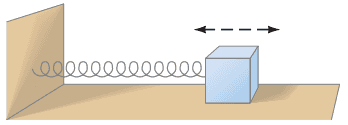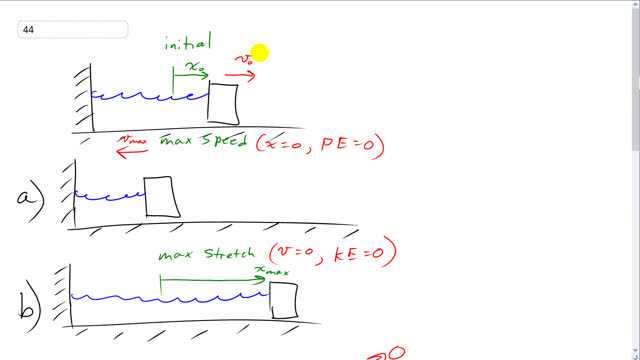
A block of mass is attached to the end of a spring (spring stiffness constant ), Fig. 6–43. The mass is given an initial displacement from equilibrium, and an initial speed . Ignoring friction and the mass of the spring, use energy methods to find
- its maximum speed, and
- its maximum stretch from equilibrium, in terms of the given quantities.

- see video
- see video

In order to watch this solution you need to have a subscription.
This is Giancoli Answers with Mr. Dychko. This spring is initially stretched some distance, x naught, and it's given some speed, v naught. So, it has some initial elastic potential energy and it has some kinetic energy. And the total of the elastic potential and the kinetic energy, that total amount of energy is gonna be the same throughout while it's going back and forth because there's no energy being lost to friction, we assume. Now in part (a), the maximum speed will occur when the block is at this spring's equilibrium position, when there's no potential energy and all of the energy is gonna be kinetic in this case. And so we'll do that for part (a). And then part (b) will have the maximum stretch happening when there's no speed; in other words, when the kinetic energy is zero. So for part (a), we have initial kinetic plus initial potential equals when we have maximum kinetic energy and no potential energy and because the spring isn't stretched at all, at this position. And that's one-half m v naught squared plus one-half k x naught squared equals one-half m v max squared. And then we can solve this for v max; the one-halves cancel everywhere divide each term by m, so this becomes just v naught squared and this becomes k x naught squared over m. And then take the square root of both sides, and we have this, v max is square root of v initial speed squared plus k times the initial stretch squared over mass. And then for the case, where we are finding the maximum stretch, we have the same initial kinetic and potential energies equals one-half k times the maximum stretch squared. And the one-halves cancel everywhere, divide each term by k and then take the square root of both sides and we have the maximum stretch is the square root of x naught squared plus m v naught squared over k.